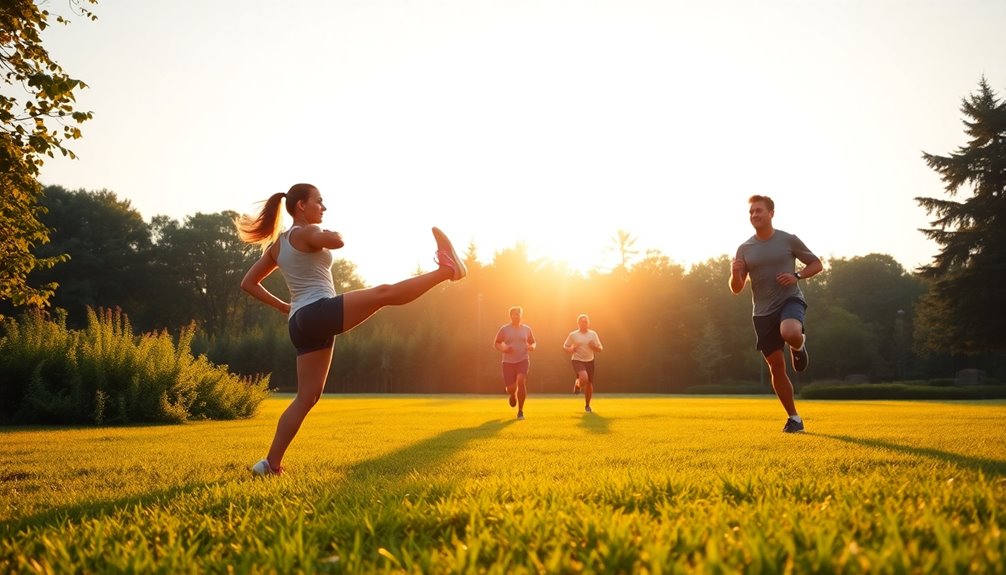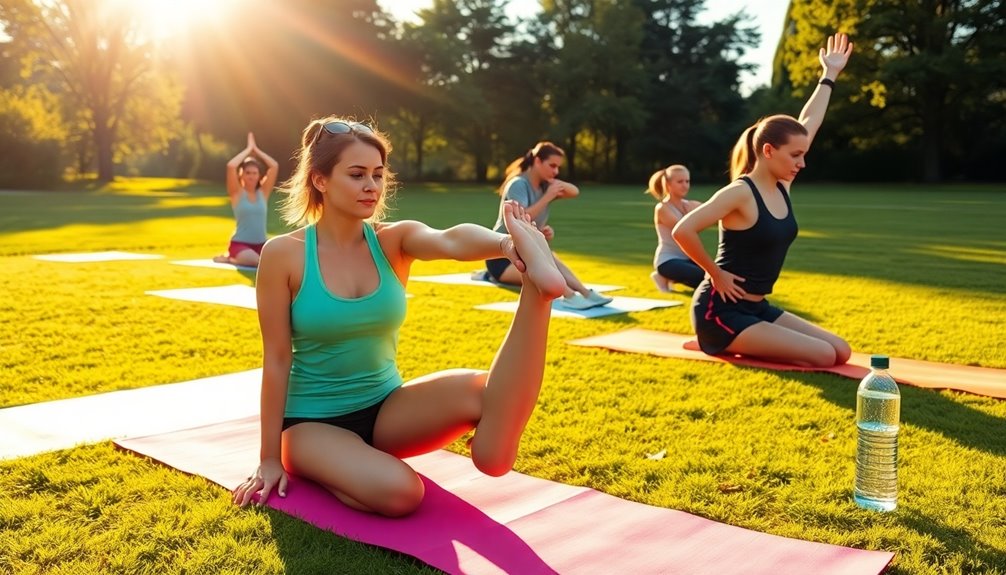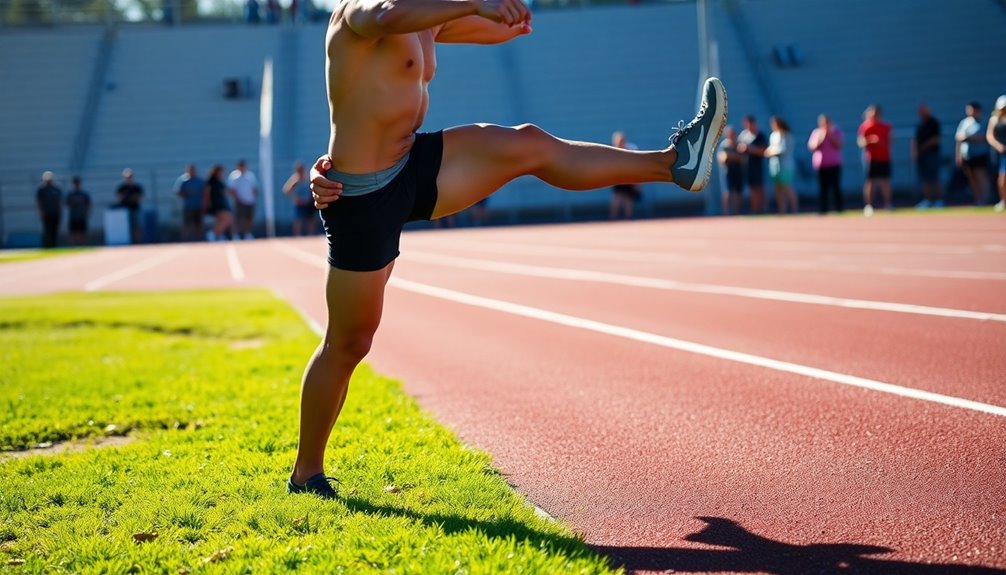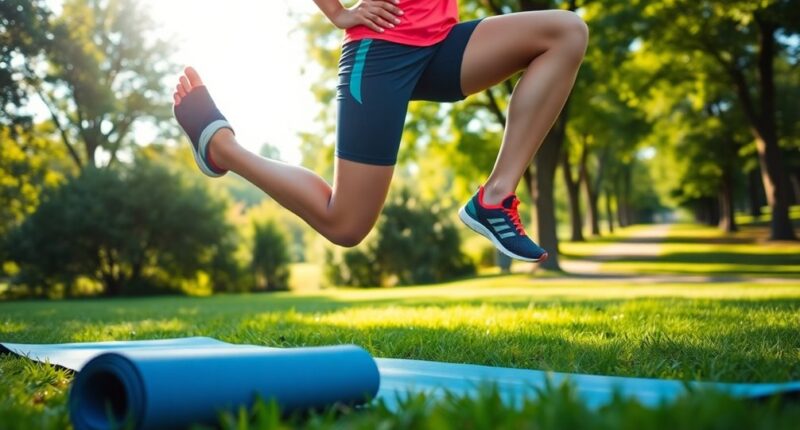Stretching is essential for you as a runner. Start with dynamic stretches like lunges and leg swings to warm up your muscles before hitting the road. After your run, incorporate static stretches such as quadriceps and hamstring stretches to enhance recovery and flexibility. Hold each stretch for 10 to 30 seconds. Regular stretching not only prevents injuries but also improves your overall performance. Keep going to discover more effective techniques that can elevate your running game!
Key Takeaways
- Incorporate Dynamic Stretches: Use dynamic stretches like lunges and leg swings before runs to warm up muscles and improve range of motion.
- Focus on Key Muscle Groups: Target major muscle groups such as hip flexors, quadriceps, hamstrings, and calves to enhance flexibility and prevent injuries.
- Utilize Static Stretching Post-Run: Perform static stretches after running to alleviate tightness and improve recovery, holding each stretch for 10 to 30 seconds.
- Prioritize Consistency: Establish a regular stretching routine to enhance long-term flexibility, support recovery, and reduce injury risk.
- Listen to Your Body: Modify stretches based on your individual flexibility levels and focus on tight areas to avoid discomfort and ensure effectiveness.
Importance of Stretching for Runners

Stretching isn't just an afterthought for runners; it's essential for your overall performance and injury prevention. By incorporating stretching into your routine, you improve flexibility in key muscle groups used during running. This enhanced flexibility helps prevent muscle tension and reduces your risk of injuries.
Static stretching after your runs can boost muscle recovery, alleviate tightness, and improve blood circulation, making you feel better post-workout. Aim to hold each stretch for 10–30 seconds while focusing on proper breathing techniques. Additionally, incorporating anti-inflammatory breakfasts into your diet can further support your recovery and overall performance.
Regularly stretching not only contributes to better running performance by maintaining your muscles' flexibility but also leads to improved running mechanics. Combining both dynamic stretching before your runs and static stretching afterward guarantees you're physically ready and supports long-term health benefits.
Dynamic Stretching Techniques

Dynamic stretching techniques are essential for warming up your muscles before a run.
Key movements like lunges and leg swings not only engage your muscles but also improve your range of motion. Additionally, incorporating beet juice into your pre-run routine may enhance your performance by improving blood flow and increasing stamina.
Warm-Up Benefits
When you incorporate dynamic stretching into your warm-up routine, you're not just increasing blood flow; you're also preparing your muscles for the demands of running.
Dynamic stretching techniques, like lunges and leg swings, enhance flexibility, which allows for a greater range of motion in your hips and legs. By engaging in these stretches for 10 to 15 minutes, you can notably reduce the risk of muscle strains and injuries.
Additionally, dynamic stretching activates muscle groups and improves neuromuscular coordination, boosting your athletic performance. This warm-up benefits your running technique by promoting better mechanics and posture, ultimately leading to a more efficient run. Furthermore, just as with emergency preparedness essentials, a properly executed warm-up can significantly enhance your overall performance and reduce the chances of injury during your runs.
Key Movements Explained
To effectively prepare your body for running, incorporating key dynamic stretching movements is essential. These techniques not only enhance leg mobility but also activate vital muscle groups.
| Movement | Benefits | Targeted Muscles |
|---|---|---|
| Lunge and Lean | Warms up hip flexors | Hip flexors, glutes |
| Leg Swings | Improves blood flow and mobility | Hip joints |
| High Knees | Activates hip flexors and quadriceps | Hip flexors, quadriceps |
| Butt Kickers | Stretches quadriceps, engages hamstrings | Quadriceps, glutes |
Incorporating arm circles helps loosen your shoulders, allowing for a natural arm swing, which contributes to better running form. Additionally, quick meal options like the Turkey Bean and Tomato Zoodle Bowl can provide the necessary fuel to support your running routine. Embrace these dynamic stretching techniques for a successful run!
Timing and Frequency
Incorporating dynamic stretching into your pre-run routine is essential for maximizing performance and preventing injuries. Spend 5 to 10 minutes warming up your muscles with dynamic stretches to increase blood flow and enhance flexibility.
Techniques like leg swings, lunges with a twist, and high knees are excellent choices. Aim for 10 to 15 repetitions of each to engage key muscle groups effectively. Targeting your hips, quads, hamstrings, and calves not only prepares your body for running but also improves your overall range of motion. Additionally, engaging in positive reinforcement from dads can further enhance your motivation and enjoyment of running as a family activity.
Static Stretching Techniques

Now that you've warmed up with dynamic stretches, it's time to focus on static stretching techniques for post-run recovery.
These stretches not only help improve flexibility but also prevent muscle stiffness. Incorporating natural supplements like turmeric's anti-inflammatory properties can further enhance your recovery process.
Let's explore effective methods, the benefits they offer, and common mistakes you should steer clear of.
Benefits of Static Stretching
Static stretching offers numerous benefits for runners, particularly when performed after a run. By targeting major muscle groups like the quadriceps, hamstrings, and calves, you can enhance your recovery and maintain peak muscle function.
Here are some key benefits:
- Improved Flexibility: Elongating muscles increases your range of motion, boosting overall running performance.
- Reduced Injuries: Addressing muscle imbalances helps prevent injuries and promotes proper joint alignment.
- Enhanced Muscle Elasticity: Regular static stretching improves muscle elasticity, leading to better running efficiency and decreased strain risk.
Holding each stretch for 10 to 30 seconds allows your muscles to relax and recover effectively, minimizing post-exercise soreness and tightness. Incorporating static stretching into your routine is essential for any serious runner. Additionally, understanding the importance of self-care practices can further enhance your overall performance and well-being.
Effective Stretching Techniques
After a run, using effective stretching techniques can considerably enhance your recovery and flexibility. Focus on static stretches to target the lower body and alleviate tension.
Start with the hamstring stretch: sit with one leg extended and lean forward. For your calves, perform a calf stretch by bending one leg forward while keeping the other straight. To relieve tightness in the iliotibial band, cross one ankle behind the other and stretch your torso to the side.
Incorporate a variety of stretches, like the seated hamstring stretch and knee hug, to promote muscle recovery and prevent injuries. Hold each stretch for 10–30 seconds to maximize benefits and keep your muscles healthy and flexible. Additionally, proper nutrition is essential for overall recovery, as it influences muscle repair and flexibility.
Common Mistakes to Avoid
While you might be enthusiastic to enhance your flexibility through stretching, there are common mistakes that can hinder your progress and lead to injury.
Remember that effective stretching involves more than just going through the motions. To maximize your results, keep these tips in mind:
- Avoid bouncing during static stretches; this can strain your muscles.
- Ascertain each stretch is held for a minimum of 10–30 seconds to let your muscles relax.
- Focus on breathing deeply to boost oxygen flow and promote relaxation.
Always listen to your body—do not stretch to the point of pain. Additionally, maintaining a clean environment, similar to how air purifiers improve air quality, can enhance your overall flexibility and performance.
Modify stretches based on your flexibility levels to prevent misalignment and injuries.
Key Muscle Stretches for Recovery

Incorporating key muscle stretches into your recovery routine can greatly enhance your post-run experience.
Take the time to stretch your quadriceps by pulling your leg behind you for 30 seconds, relieving tension in the front thigh.
For your hamstrings, sit with one leg extended and lean forward to reach your toes, holding for another 30 seconds to boost flexibility.
Don't forget your calf muscles—bend one leg forward while keeping the other straight for 30 seconds to prevent tightness.
Stretch your gluteal muscles by lying down, crossing an ankle over your knee, and pulling your leg toward your chest.
These stretches will aid in your recovery and help reduce post-run soreness effectively. Additionally, understanding your body's needs during recovery, similar to recognizing nutrition deficiencies in pregnancy cravings, can further enhance your post-run care.
Techniques for Effective Stretching

To maximize the benefits of your stretching routine, it's important to employ effective techniques that enhance muscle recovery and flexibility. Incorporate both dynamic stretching before your runs and static stretches afterward to promote muscle relaxation.
Hold each static stretch for 10 to 30 seconds, focusing on controlled breathing to deepen your relaxation. Remember to modify stretches based on your individual flexibility levels to avoid pain or discomfort.
Here are three key points to keep in mind:
- Use dynamic stretches to warm up and static stretches for recovery.
- Practice deep, controlled breathing during your stretches.
- Be consistent with your routine to support long-term flexibility and injury prevention.
With these techniques, you'll optimize your stretching routine and enjoy better running performance.
Injury Prevention and Recovery

Stretching plays an essential role in preventing injuries and aiding recovery for runners. Regular post-run stretching routines can greatly reduce the risk of injury by alleviating muscle tension and promoting flexibility in key muscle groups.
By focusing on tight areas like the hip flexors, hamstrings, and calves, you maintain proper alignment and decrease the likelihood of issues such as shin splints and runner's knee. Holding each stretch for 10–30 seconds post-run enhances recovery by increasing blood flow and nutrient delivery to fatigued muscles.
This practice not only speeds up healing but also improves overall mobility, ensuring you can continue your running regimen without setbacks. Prioritizing injury prevention through effective stretching will keep you in the game longer.
Benefits of Stretching

A well-rounded stretching routine offers numerous benefits that can greatly enhance your running experience. By incorporating regular stretching, you can enjoy:
- Improved flexibility and range of motion, boosting your running performance.
- A reduced risk of muscle strains and injuries, thanks to increased muscle elasticity.
- Quicker recovery post-run, helping to alleviate soreness and stiffness.
Additionally, stretching enhances blood circulation, which is essential for delivering nutrients and oxygen to your muscles during recovery.
Studies show that consistent stretching contributes to a lower incidence of running-related injuries, supporting your long-term running health.
Embracing a stretching routine can make a significant difference in how you feel and perform, allowing you to run at your best while minimizing the risk of setbacks.
Final Thoughts on Stretching and Running

Regular stretching is more than just a routine; it's a game-changer for runners looking to enhance their performance and well-being.
Incorporating dynamic stretching before your run, like lunges and leg swings, boosts blood flow and preps your muscles for the task ahead.
After your run, static stretching, such as the seated hamstring stretch and calf stretch, is essential for reducing muscle soreness and improving flexibility.
Remember to hold each static stretch for 10 to 30 seconds to help your muscles relax, elongate, and promote recovery.
By regularly practicing this thorough stretching routine, you'll not only enhance your running technique but also greatly decrease your risk of injury.
Prioritize stretching, and you'll reap the benefits in every stride.
Frequently Asked Questions
What Stretches Should a Runner Do?
As a runner, you should focus on both dynamic and static stretches.
Before your run, try lunges and leg swings to warm up your muscles.
Afterward, incorporate static stretches like the seated hamstring stretch and standing quad stretch, holding each for 10–30 seconds.
Don't forget to include the piriformis stretch to relieve hip tightness and the child's pose for back flexibility.
These stretches will enhance your recovery and overall performance.
What Are the 4 Rules of Stretching?
Think of stretching like tuning a guitar; it's essential for harmony.
To stretch effectively, remember four key rules:
First, always warm up before you start.
Second, hold each stretch for 10 to 30 seconds to let your muscles relax.
Third, avoid bouncing to prevent strains—smooth movements are your best friends.
Finally, listen to your body; if something hurts, stop.
Stick to these rules, and you'll keep your flexibility in tune!
Which of the 4 Types of Stretching Is Not Recommended?
When it comes to stretching, static stretching isn't recommended before you run. Instead, it can temporarily weaken your muscles, reducing your performance and increasing the risk of injury.
Before hitting the pavement, focus on dynamic stretching to warm up your body; it boosts blood flow and activates your muscles.
Save static stretching for after your run to help with muscle relaxation and flexibility, ensuring you're ready for your next workout.
Is It Better to Do Static or Dynamic Stretches After Running?
You might think static stretching is just about flexibility, but it's actually essential for recovery too.
After running, it's better to focus on static stretches, as they help relax your muscles and reduce soreness. Holding each stretch for 10-30 seconds targets the major muscle groups you just worked.
This not only promotes flexibility but also aids in recovery, ultimately enhancing your overall performance and lowering your risk of injury.
Conclusion
So, if you think you can just lace up and hit the pavement without a good stretch, go ahead! Just remember, those hamstrings don't appreciate being treated like forgotten gym equipment. Embrace the art of stretching—your body will thank you, and you might just dodge the dreaded "runner's limping shuffle." After all, who doesn't want to look graceful while they're gasping for air at mile two? Stretching isn't just a suggestion; it's your ticket to running glory!









